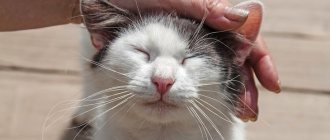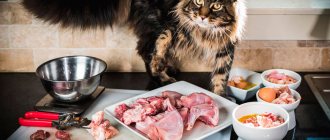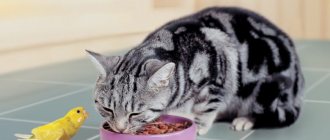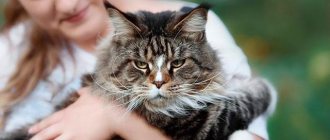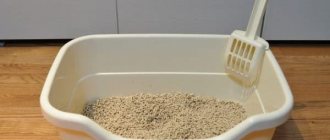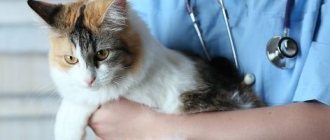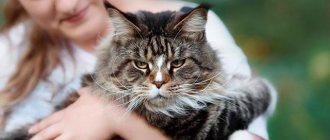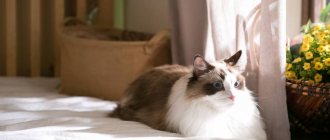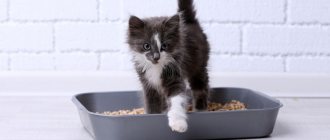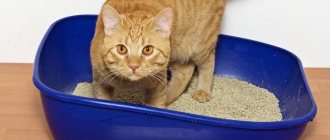July 21, 2018
Some cats crunch the dry granules with pleasure, while others turn away from the bowl with contempt. Is it possible to re-educate a mustachioed gourmet? Experienced cat owners know: everything is possible if you strictly follow the intended goal. Read our selection of tips on how to train your cat to eat dry food.
Benefits of dry food
Every person who has become the owner of a furry ball wonders what to feed. Natural products or drying. Everyone understands that animals are not fed food from the table. It is necessary to prepare separately, carefully monitoring so that the diet is balanced. It is difficult to do this without having certain skills.
Veterinarians recommend feeding your pet a commercial diet for a number of reasons:
- The composition is balanced. Everything is here in the right quantity - vitamins, minerals, proteins, fats, carbohydrates.
- It saves time, plus it’s easy to calculate the volume of portions.
- Dry granules clean teeth from plaque, thereby preventing oral diseases.
- Wide choice - there are different classes of food, products by age, for a specific breed, hypoallergenic, preventive, therapeutic, for weight gain, for weight loss.
Mixing
The main goal is to deceive visual perception. The transition in this way occurs in 21-36 days. Act like this.
- At the very beginning, add about 20 ml of water to a portion of granules to soften everything. In the second bowl, place dry food without liquid.
- Gradually reduce the contents of the latter until the animal begins to eat wet crackers more and more often.
- Leave the contents of the first bowl the same, but put natural products in the second. You can put a couple of granules for appearance and smell. Over time, they will have to be removed, which may slightly increase the adaptation time.
- Now reduce the amount of wet crackers so that the cat eats more and more food from the second bowl.
At what age should dry food be introduced?
Up to 1-1.5 months, babies are fed with mother's milk or, if they are bottle-fed, then with special formulas. Towards the end of the first month of life, baby teeth begin to emerge. Kittens no longer have enough mother's milk, especially if the litter is large. By this time, the cat itself begins to avoid young animals, so you can try to switch the kitten to dry food. Moreover, every baby strives to chew and taste something.
Artificial kittens should not be given dry granules until they reach 2.5 months. An immature digestive system will react negatively. The gastrointestinal tract is ready to digest industrial feed at the age of 2.5-3 months.
It is necessary to decide what the cat will eat - natural food or ready-made food - at exactly 1.5 months.
Before transferring a kitten to dry food, it is recommended to start complementary feeding with raw meat (turkey, chicken, rabbit). This needs to be done so that the baby’s stomach develops enzymes for processing meat products. Then you can switch to the factory diet. But you shouldn’t start complementary feeding right away with drying. To process it, completely different enzymes are required. For some time it is better to use it as an intermediate wet food: pates, canned food, pouches with pieces.
How to increase a cat's appetite?
There are several ways to increase your four-legged pet’s appetite:
- Cook your favorite dishes. If your cat loves meat, when preparing food, the emphasis should be on this product. You can try to interest animals whose favorite treat is an egg with a boiled yolk.
- Offer the cat a new dish that the little tailed little one has not yet eaten. Perhaps the cat's curiosity will rise and she will try the treat.
- Prepare liquid, flavorful food. Smell plays an important role in the formation of appetite.
- Soak dry granules if the cat eats ready-made food, or offer him tasty pieces in sauce or jelly.
- Place some catnip in a bowl.
- Buy grass for cats at a pet store. You should not waste time germinating grains yourself, as the problem requires an urgent solution.
- Give your pet vitamins approved by your veterinarian to stimulate appetite, containing seaweed, mint, yeast and other components.
Where to start training
If the kitten itself, following the mother cat, has not eaten dry croquettes, it will take a little time to accustom it. In this case, you need to act consistently, then the training process takes from 5 days to 2 weeks. You can use one of 3 options.
Soak the granules in water
Croquettes should be soaked in warm boiled water. To do this, measure out the required amount of granules and add water, close to hot (50-60 degrees). Take enough water to cover the croquettes. To speed up the process, you can grind the granules in a blender.
How much feed to give
Each manufacturer places recommendations on the daily food intake on the bag of croquettes and on its website, which depends on weight and age. It is important to follow these recommendations.
You will need to weigh the little cat. The owners know the age of the kitten. If the animal is taken from the street or purchased at the market, then it is better to ask the veterinarian to determine the age of the kitten - whether it has reached 20 weeks (5 months) or not.
Next, check the manufacturer’s data, where the norm is calculated per 1 kg of weight. Depending on the company, the daily norm for a kitten up to 20 weeks can be 48 - 60 grams. per 1 kg. Thus, for a kitten up to 5 months, 48 grams per day is enough to cover all energy costs and replenish the supply of nutrients.
Animals that have reached six months of age require less feed - an average of 30 grams. per 1 kg. By 12 months, the pet is considered an adult and its norm is the same as that of an adult animal (see manufacturer’s recommendations).
Calculation example:
- Kitten weight 500 g. or 0.5 kg.
- The kitten is 3 months old.
- Calculation: 0.5 kg * 48 g. (norm) = 24 g. And this is for the whole day.
The daily dose is divided into equal parts and given to the pet in several feedings. The younger the cat, the more often it is fed - up to 4-6 times a day, but in small portions. If the owner fills the bowl with a tubercle, then it is likely to make the wrong conclusion that the kitten is not eating. That's right - he just can't eat that much.
Foods cats love most
There are foods that most cats like:
- meat;
- fish;
- fermented milk products (kefir, cottage cheese, yogurt, cheese, fermented baked milk);
- eggs.
These foods are best for whetting your pet's appetite. To restore your animal's interest in food, you can try giving him a boiled yolk, a small piece of low-fat cheese, a ball of minced meat, and a little sour cream.
Share with friends!
Scheme for transferring to a dry diet
A common scheme for transferring a kitten from natural food to dry food is designed for 14 days. The goal is to increase the amount of dry granules every day, gradually replacing other foods.
- Start by replacing approximately 1/4 of the daily value with drying in the first 4 days. So, if a kitten eats 100 grams per day. food (natural or canned), then ¼ part is 25 grams. It needs to be removed. 75 g left. usual food. Also separate ¼ of the daily intake of dry food (see the manufacturer). If it is determined that the daily dose of drying is 24 grams, then the fourth part is measured, i.e. 6 gr.
What to consider when training
To avoid mistakes when switching to a new diet, you should adhere to the following recommendations:
- Some people are guided by the principle: “if he wants, he will eat.” This is the wrong tactic, which can lead to future health problems. You cannot force a kitten to eat dry food or scold it.
- It is important to ensure that your pet drinks water. There is no water in the granules, and for them to soften in the body, you need a lot of water. Therefore, the bowl should always be filled with clean water. When leaving home for a long time, it is better to leave several containers of water, in case the kitten turns over one of them.
- If croquettes are mixed with wet food, then after each meal, the remains are thrown away. This mixture quickly weathers, deteriorates and acquires an unpleasant odor. An option is to learn how to calculate the dosage of servings.
- It is correct to store croquettes in a well-closed bag or box. When exposed to air, the granules oxidize, acquiring an unpleasant odor for the animal. A kitten already accustomed to drying will refuse such a “treat”.
How to make a kitten eat?
One of the following methods will help you encourage your kitten to eat:
- Bring your finger, on which a little food is applied, to the baby's face. Perhaps this way it will be possible to awaken in him the desire to eat.
- Holding the baby by the head, slowly introduce liquid food into his cheek from a small syringe, pipette or baby bottle.
- Pour slightly warmed milk into a bowl, bring the baby to it and wet his nose with it.
What food to choose
Everyone knows that there are several classes of food and species within each class. A cheap, economy option is a recipe for disease and an underdeveloped skeleton, which ultimately shortens the cat’s life expectancy.
To accustom a kitten to ready-made food, you need to use only super premium food or holistic food. This class includes products from the brands Orijen, Acana, Applaws, Grandin, Natural Greatness. It is advisable to use a product designed specifically for kittens with small pellets. It is also acceptable to feed pellets to pregnant and lactating cats. This product is high in calories and contains many additives for proper development.
Once the kitten has switched to dry food, it is no longer possible to “diversify” the menu with natural food. You can give canned food and pates, but not at the same feeding with croquettes.
Pros and cons
Of course, there is no consensus on whether cats can be given dry food or not. And veterinarians don't always agree. But it is worth saying that dry food has a balanced composition, is complete, and therefore can be used for feeding kittens.
Attention! Especially for the little ones, ingredients that are as safe and easy to digest as possible are added so that there are no problems with digesting food.
According to other veterinarians, cats should not be fed dry food because they are carnivores by nature. In addition, feeds existing on the market do not always meet the content requirements. But in fact, good, and therefore expensive, food is an excellent solution, since it consists of natural ingredients that are safe for babies.
Especially for the little ones, ingredients that are as safe and easily digestible as possible are added.
Modern pet products include a variety of foods with different flavors and contents. But if you consult with a veterinarian and monitor the condition of your kitten, you can easily select dry food and accustom your pet to it as competently as possible without compromising its health and activity. The main thing is to train correctly, following the advice of professionals!

